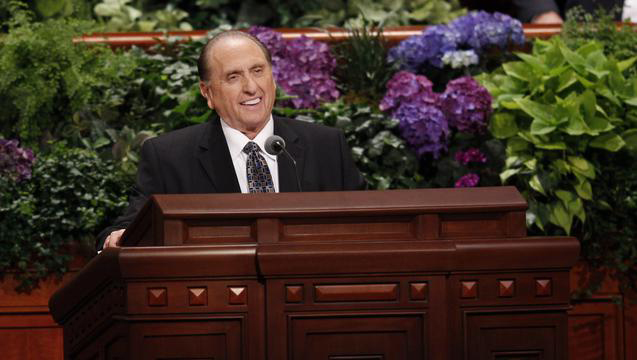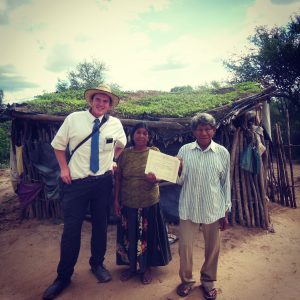
It has been five years since LDS Church President Thomas S. Monson announced in General Conference that men could serve as missionaries at age 18 instead of 19, and women could serve at age 19 instead of 21.
Since the missionary age change announcement on Oct. 6, 2012, there has been a 20 percent increase in young adults who serve full-time missions, and a 21 percent increase of the number of missions worldwide.
The 2012 statistical report of The Church of Jesus Christ of Latter-day Saints cited 58,990 full-time missionaries and 347 missions. In the most recent 2016 report, there were 70,946 missionaries and 421 missions.
Impact on BYU’s student body
BYU saw an 8 percent increase of male students who are returned missionaries and a 32 percent increase in female students who are returned missionaries from the fall semester of 2012 to Fall 2017, according to University Communications Media Relations Manager Todd Hollingshead.
In Fall 2012, 46 percent of BYU’s student body had served missions. This fall semester, 65 percent of BYU students have served missions — a 19 percent increase over the last five years.
Many BYU students decided to serve missions because of the missionary age change.
BYU alumna Cassandra Donakey left on her mission to Milan, Italy, three weeks after she turned 19.
“I had many conversations about serving a mission during my life,” Donakey said. “My attitude about serving a mission was that I would go if I was given the opportunity.”
BYU master’s student Hannah Denney was in the Conference Center when the age change announcement was made.
Denney said she took a missionary preparation course at BYU the semester after the age change to “explore the idea more.”
“Although it wasn’t a part of my plan initially … my desire really grew and I became more and more excited to serve a mission,” Denney said.
Michael Goodman, an associate religion professor at BYU, teaches a missionary preparation course. Goodman said he still sees the effects of the missionary age change in his classroom.
“The largest impact the age change has made to BYU mission prep classes has been a change in gender balance,” Goodman said. “Fall semester has almost flipped, with most classes being majority female students.”
Denney said in general there was some peer pressure among females at BYU to serve a mission because everyone was going. However, Goodman said those who are not inspired to serve shouldn’t be made to feel any less faithful or worthy.
In certain cases, serving a mission could be “impossible or inadvisable” for some young men, and for sisters, serving a mission “is not a necessity for the growth and future success of every sister,” Goodman said.
Missionary Training Center influx, expansion
Tyler Doermann, a BYU master’s student in information systems management, was a missionary in the Provo Missionary Training Center when the age change was announced.
“Everyone cheered. It was commotion,” Doermann said. “Everyone was just stoked.”
Doermann said the missionaries were talking about their siblings or people they knew who would be influenced by the age change announcement.
BYU alumnus Ben Smith was a training coordinator over the Portuguese area at the Missionary Training Center during the missionary age change.
The missionary age change brought a “wave” of missionaries to the mission field, according to Smith.
“The effects of the missionary age change really didn’t hit the MTC in a significant way until the following summer,” Smith said. “With the age change, a lot of missionaries coming were now coming after high school graduation.”
The LDS Church began sending missionaries to international MTCs as much as possible to help lighten the load on the Provo MTC, according to Smith.
“At Provo, I believe they put cots up in the residence halls in order to fit more missionaries,” Smith said.
BYU junior Gary Smithson served at age 18 as a result of the age change. He said the Provo MTC was filled with so many missionaries who were excited about the work.
“Both the missionaries and the people working at the MTC felt that special spirit that came with the hastening of the work of salvation,” Smith said.

Utah State University alumna Caitlyn Erickson said she fasted, prayed and went to the temple to make sure a mission was right for her. When Erickson reported to the MTC on June 19, 2013, she was dropped off at Wyview Park instead of the Provo MTC.
Wyview and Raintree Commons Apartments in Provo were used as a ‘West Campus’ facility for the Provo MTC to accommodate the influx of missionaries.
Erickson said her missionary group lived at Wyview and had their missionary classes at Raintree. Erickson said the experience was weird and wasn’t what many missionaries there expected.
However, Erickson said the spirit could be felt just as strongly there as on the main MTC campus.
“There was an overwhelming feeling of being back home,” Erickson said of returning to the West Campus MTC from the main MTC campus after getting clothes altered. “It was a reassurance that the spirit that is at this MTC is the exact same spirit at the main MTC.”
Mission field adjustments
As more missionaries entered the MTC, those already in the mission field made arrangements for all the new elders and sisters coming in.
“When I first got out, there were four sister missionaries in the whole mission, and two of them were in our zone,” Doermann said.
Within six months of being in the mission field, Doermann said his mission saw huge influxes of missionaries coming each transfer, and most were sisters. He said zones of his mission changed to 50 percent sisters and 50 percent elders.
Smithson said new areas were opened because so many missionaries were coming into the mission field.

“When I first got to the mission, my companion and I opened up a new area,” Smithson said. “Missionaries hadn’t been there for years because there weren’t enough missionaries.”
Nerina Harper was an Italian teacher at the MTC during the influx of missionaries. Harper said she thinks the age change gave elders a “stronger sense of responsibility.”
“With so many sisters rising to the call, I believe it helped the young men of the church strive for a higher standard,” Harper said.
Denney said the age change affected the women in the church in a large way because more sisters were being trained to teach the gospel and become leaders.
“With many more people returning from full-time missionary service, there is also an increase in gospel knowledge and personal spiritual maturity that comes with it,” Goodman said.
In the 2012 age change announcement, President Monson said previous missionaries who served at age 18 showed similar obedience, faith and maturity as older missionaries in their missions.
“The brethren have a lot of confidence in the youth of the church,” Denney said.




